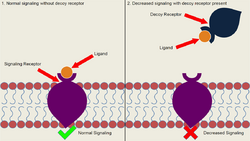Biology:Decoy receptors
A decoy receptor is a receptor that is able to recognize and bind specific growth factors or cytokines efficiently, but is not structurally able to signal or activate the intended receptor complex. It acts as an inhibitor, binding a ligand and keeping it from binding to its regular receptor. Decoy receptors participate in a common methods of signal inhibition and are also abundant in malignant tissues, making up a significant topic in cancer research.[1]
Examples
Interleukin 1 receptor type II
IL1R2 was one of the first identified decoy receptors.[2] [3] It binds IL1A and IL1B and inhibits their binding to IL1R1, deterring the inflammatory response which is generally promoted by the binding of type 1 interleukins to interleukin receptor 1 type I.[4]
Decoy receptor 3 (DcR3)
Also known as TNFRSF6, the DcR3 receptor is found primarily in human malignant tissues.[5] It acts as a decoy receptor for TNF cytokine members: FasL, LIGHT, and TL1A, inhibiting the ability of the cytokines to signal for cell death or apoptosis.
VEGFR-1
VEGFR-1 is a kinase-defective receptor tyrosine kinase that negatively modulates angiogenesis by acting as a decoy receptor.[6] The decoy characteristic of VEGFR-1 is required for normal development and angiogenesis. VEGFR-1 inhibits the activity of VEGFR-2 by sequestering VEGF, thus preventing VEGFR-2 from binding to VEGF.
Applications
Engineered Axl "decoy receptor"
Axl receptor tyrosine kinase has been associated with numerous diseases, most notably metastatic cancer. Axl has been shown to drive metastasis, confer therapeutic resistance and promote disease progression. Axl binds to its ligand, Gas6, and becomes activated. Decoy receptors are being designed that bind to Gas6 and prevent Axl activation.[7]
ACE-031
ACE-031 is an engineered decoy receptor and myostatin inhibitor used in attempts to treat children with Duchenne muscular dystrophy (DMD). The ACE-031 receptor circulates outside the muscle-fiber membrane. Because this receptor binds to myostatin, it lowers the amount of myostatin that can bind to the native receptor in the membrane (ActRIIB), preventing myostatin from delivering the muscle growth-limiting signal.[8]
References
- ↑ Encyclopedia of Cancer. Springer Berlin Heidelberg. 2012. pp. 1070. doi:10.1007/978-3-642-16483-5_6693. ISBN 978-3-642-16482-8.
- ↑ McMahan, CJ; Slack, JL; Mosley, B (1991). "A novel IL-1 receptor, cloned from B cells by mammalian expression, is expressed in many cell types.". The EMBO Journal 10 (10): 2821–2832. doi:10.1002/j.1460-2075.1991.tb07831.x. PMID 1833184.
- ↑ Re, FExpression error: Unrecognized word "etal". (1994). "The type II "receptor" as a decoy target for interleukin 1 in polymorphonuclear leukocytes: characterization of induction by dexamethasone and ligand binding properties of the released decoy receptor.". The Journal of Experimental Medicine 179 (2): 739–743. doi:10.1084/jem.179.2.739. PMID 8294881.
- ↑ "IL1R2 interleukin 1 receptor, type II [ Homo sapiens (human) "]. National Center for Biotechnology Information. 2015. https://www.ncbi.nlm.nih.gov/gene?Db=gene&Cmd=ShowDetailView&TermToSearch=7850.
- ↑ Ashkenazi, Avi (1 June 2002). "Targeting death and decoy receptors of the tumour-necrosis factor superfamily". Nature Reviews Cancer 2 (6): 420–430. doi:10.1038/nrc821. PMID 12189384.
- ↑ Meyer, Rosana D.; Mohammadi, Moosi; Rahimi, Nader (13 January 2006). "A Single Amino Acid Substitution in the Activation Loop Defines the Decoy Characteristic of VEGFR-1/FLT-1*". The Journal of Biological Chemistry 281 (2): 867–875. doi:10.1074/jbc.M506454200. PMID 16286478.
- ↑ Kariolis, Mihalis S (21 September 2014). "An engineered Axl 'decoy receptor' effectively silences the Gas6-Axl signaling axis". Nature Chemical Biology 10 (11): 977–983. doi:10.1038/nchembio.1636. PMID 25242553.
- ↑ Attie, Kenneth M (21 November 2012). "A single ascending-dose study of muscle regulator ace-031 in healthy volunteers". Muscle and Nerve 47 (3): 416–423. doi:10.1002/mus.23539. PMID 23169607.
External links
- Mantovani, Alberto; Locati, Massimo; Vecchi, Annunciata; Sozzani, Silvano; Allavena, Paola (June 2001). "Decoy receptors: a strategy to regulate inflammatory cytokines and chemokines". Trends in Immunology 22 (6): 328–336. doi:10.1016/S1471-4906(01)01941-X. PMID 11377293.
- Ashkenazi, Avi; Dixit, Vishva M. (April 1999). "Apoptosis control by death and decoy receptors". Current Opinion in Cell Biology 11 (2): 255–260. doi:10.1016/S0955-0674(99)80034-9. PMID 10209153.
 |


